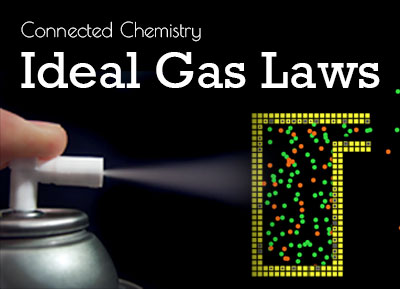
Overview
This is a 2 week unit designed to cover high-school and introductory college level topics in the properties of gases and gas particle behavior. The unit includes eight lessons. Each lesson uses computer models to explore these topics in greater depth. The models also afford greater degree of student inquiry and guided discovery than would be typically possible through other learning activities in the same amount of time.
The computer models enable students to investigate what causes pressure in a gas, how it is measured, and how it is affected by the properties of the particles that make the gas and the characteristics of the container they are in. Students are encouraged to understand how the principles and effects of pressure are generated from specific interactions between many particles (or simplified gas molecules) and with their environment. To do this, students gain a familiarity with a microscopic view of the gas particles by running many different computer models of systems of gas particles. Some initial models are designed for orienting the student to the NetLogo interface and the practice of computer-based modeling, others are designed for specific data gathering and data analysis tasks.
The later computer models focus on how particles behave in a variety of conditions. Such conditions include varying the number of particles, the size of the particles, the speed of the particles, and the location of solid walls they bounce off. These variations support students explorations of the models to design new variations into the model (adding new rules for particle behavior, designing new system boundaries), designing experiments and testing predictions with the models, and deriving mathematical models (symbolic representations of relationships that they find in graphs and table they build from data they gather in their experiments). The mathematical modeling of relationships between variables such as the number of gas particles, the temperature of a gas, the volume of the gas container, gas constants, and the pressure of the gas, helps students to progressively expand and derive the gas laws from experimental data. This mathematical modeling focus, helps students bridge the symbolic representations of the gas laws, to experimental data, to particle behavior.
The non-computer based activities ask students to apply ideas and relationships learned in class, extend the predictions of these relationships to new situations that they experience every day, and connect previous and upcoming concepts to their understanding of particle behavior (Kinetic Molecular Theory) and to broader cross cutting themes in science. Some of the broad cross cutting themes include building and using scientific models, systems thinking, data analysis, and change and equilibrium.
These activities will build a deep and intuitive sense of particle behavior that will extend readily to other chemistry topics. In particular, the behavior of particles in chemical reactions becomes easy to envision and predict the outcome of the interactions of molecules, even when the reactants are in solid or liquid form. This is because many of the concepts related to chemical reactions rely on an understanding of the number of molecules, volume, and temperature, and pressure.
Teacher Guide (pdf)
Underlying Lessons
Standards
Next Generation Science Standards
- Physical Science
- NGSS Crosscutting Concept
- NGSS Practice
Computational Thinking in STEM
- Data Practices
- Modeling and Simulation Practices
- Computational Problem Solving Practices
- Systems Thinking Practices
Credits
The 2019 version of this unit is developed by Umit Aslan (umitaslan@u.northwestern.edu) and Nicholas LaGrassa (nicholaslagrassa2023@u.northwestern.edu).
Acknowledgement
A majority of this unit is adopted from the earlier Connected Chemistry units developed by Uri Wilensky, Mike Stieff, Sharona Levy, and Michael Novak (see http://ccl.northwestern.edu/rp/mac/index.shtml for more details). Some elements are also taken from the Particulate Nature of the Matter unit developed by Corey Brady, Michael Novak, Nathan Holbert, and Firat Soylu (see http://ccl.northwestern.edu/rp/modelsim/index.shtml for more details).
We also thank undergraduate research assistants Aimee Moses, Carson Rogge, Sumit Chandra, and Mitchell Estberg for their contributions.
